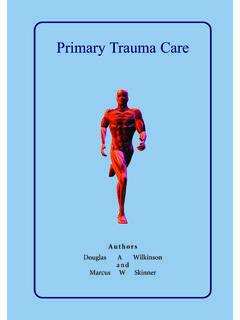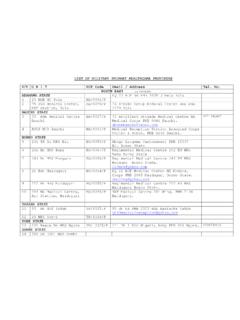Transcription of Primary Trauma Care Manual
1 Primary Trauma CareAuthorsDouglas A WilkinsonandMarcus W SkinnerPrimary Trauma CarePrimary Trauma care ManualStandard Edition2000A Manual for Trauma Managementin District and Remote LocationsISBN 0-95-39411-0-8 Published by Primary Trauma care FoundationNorth House, Farmoor Court, Cumnor Road, Oxford OX2 9 LUEmail: be copied with permission from the Trauma CareContents Introduction .. 3 Trauma in Perspective .. 4 ABCDE of Trauma .. 5 Airway Management .. 7 Ventilation (Breathing) Management .. 8 Circulatory Management .. 9 Secondary Survey .. 12 Chest Trauma .. 14 Abdominal Trauma .. 17 Head Trauma .. 19 Spinal Trauma .. 21 Limb Trauma .. 23 Special Trauma Cases .. 25 Paediatrics .. 25 Pregnancy .. 27 Burns .. 28 Transportation of the Trauma Patient.
2 29 AppendicesAppendix 1:Airway Management Techniques .. 30 Appendix 2:Paediatric Physiological Values .. 32 Appendix 3:Cardiovascular Parameters .. 33 Appendix 4:Glasgow Coma Scale .. 33 Appendix 5:Cardiac Life Support .. 34 Appendix 6: Trauma Response .. 35 Appendix 7:Activation Plan for Trauma Team .. 36 Primary Trauma CareIntroductionTrauma transcends all national boundaries. Many less affluent countries have asignificant proportion of road and industrial Trauma in a generally youngpopulation. Morbidity and mortality associated with such Trauma can be reducedby early and effective medical Primary Trauma care course is intended to provide basic knowledge and skillsnecessary to identify and treat those traumatised patients who require rapidassessment, resuscitation and stabilisation of their injuries.
3 This course willparticularly highlight the need for early recognition and timely intervention inspecific life-threatening course is intended to provide material by lectures and practical skill stationsthat represents an acceptable method of management for Trauma . It provides avery basic foundation on which doctors and health workers can build the necessaryknowledge and skills for Trauma management with minimal equipment and withoutsophisticated technological are several very successful and well organised Trauma courses and manualsavailable, including the American College of Surgeons ATLS course and the EMSTA ustralian course. These courses are directed to medical personnel in well equippedhospitals with oxygen, communication and transport etc. and offer a comprehensivesyllabus.
4 The Primary Trauma care is not a substitute for these courses, but usessimilar basic principles and emphasises basic Trauma care with minimal ObjectivesAt the completion of this course you should:1. Understand the priorities of Trauma management2. Be able to rapidly and accurately assess Trauma patients needs3. Be able to resuscitate and stabilise Trauma patients4. Know how to organise basic Trauma care in your Trauma CareTrauma in PerspectiveMost countries of the world are experiencing an epidemic of Trauma , but the mostspectacular increase has been in the developing countries. Proliferation of roadsand use of vehicles has led to a rapid increase in injuries and deaths and manyperipheral medical facilities find themselves faced with multiple casualties frombus crashes or other disasters.
5 Severe burns are also common in both urban andrural number of important differences between high and low-income countries makedevelopment of a specifically designed Primary Trauma care Course include: the great distances over which casualties may have to be transported to reacha medical facility the time taken for patients to reach medical care the absence of high-tech equipment and supplies the absence of skilled people to operate and service of Trauma is by far the cheapest and safest mode to manage depends on the location s resources and factors such as: culture manpower politics health budget effort should be made by the medical Trauma teams to address the abovefactors in the prevention of Trauma . Much of this lies beyond the scope of thismanual, but time will be spent on the course looking at local circumstances andprevention Trauma CareABCDE of TraumaThe management of severe multiple injury requires clear recognition ofmanagement priorities and the goal is to determine in the initial assessment thoseinjuries that threaten the patient s life.
6 This first survey, the Primary survey, ifdone correctly should identify such life-threatening injuries such as: airway obstruction chest injuries with breathing difficulties severe external or internal haemorrhage abdominal there is more than one injured patient then treat patients in order of priority(Triage). This depends on experience and resources (Discussed in the practicalsessions).The ABCDE survey (Airway, Breathing, Circulation, Disability and Exposure) isundertaken. This Primary survey must be performed in no more than 2 5 treatment of injuries can occur when more than one life-threateningstate exists. It includes: AirwayAssess the airway. Can patient talk and breathe freely? If obstructed, the steps to beconsidered are: chin lift/jaw thrust (tongue is attached to the jaw) suction (if available) guedel airway/nasopharyngeal airway intubation.
7 NB keep the neck immobilised in neutral position. BreathingBreathing is assessed as airway patency and breathing adequacy are re-checked. Ifinadequate, the steps to be considered are: decompression and drainage of tension pneumothorax/haemothorax closure of open chest injury artificial oxygen if of ABC s must be undertaken if patient is unstablePrimary Trauma care CirculationAssess circulation, as oxygen supply, airway patency and breathing adequacy arere-checked. If inadequate, the steps to be considered are: stop external haemorrhage establish 2 large-bore IV lines (14 or 16 G) if possible administer fluid if available. DisabilityRapid neurological assessment (is patient awake, vocally responsive to pain orunconscious). There is no time to do the Glasgow Coma Scale so a awakeA verbal responseV painful responseP unresponsiveUsystem at this stage is clear and quick.
8 ExposureUndress patient and look for injury. If the patient is suspected of having a neck orspinal injury, in-line immobilization is important. This will be discussed in thepractical Primary Trauma CareAirway ManagementThe first priority is establishment or maintenance of airway patency. Talk to the patientA patient who can speak clearly must have a clear airway. The unconscious patientmay require airway and ventilatory assistance. The cervical spine must be protectedduring endotracheal intubation if a head, neck or chest injury is suspected. Airwayobstruction is most commonly due to obstruction by the tongue in the unconsciouspatient. Give oxygen (if available, via self-inflating bag or mask) Assess airwayThe signs of airway obstruction may include: snoring or gurgling stridor or abnormal breath sounds agitation (hypoxia) using the accessory muscles of ventilation/paradoxical chest movements alert for foreign bodies.
9 The techniques used to establish a patent airway areoutlined in Appendix1 and will be reviewed in the practical sessions. Intravenoussedation is absolutely contraindicated in this situation. Consider need for advanced airway managementIndications for advanced airway management techniques for securing the airwayinclude: persisting airway obstruction penetrating neck Trauma with haematoma (expanding) apnoea hypoxia severe head injury chest Trauma maxillofacial obstruction requires URGENT treatmentPrimary Trauma CareVentilation (Breathing) ManagementThe second priority is the establishment of adequateventilation. Inspection (LOOK) of respiratory rate is essential. Are any ofthe following present cyanosis penetrating injury presence of flail chest sucking chest wounds use of accessory muscles?
10 Palpation (FEEL) for tracheal shift broken ribs subcutaneous emphysema percussion is useful for diagnosis of haemothorax and pneumothorax. Auscultation (LISTEN) for pneumothorax (decreased breath sounds on site of injury) detection of abnormal sounds in the actionThis is covered in lecture and in practical sessions: see Appendix 5 the chest pleura is drained of air and blood by insertion of an intercostaldrainage tube as a matter of priority and before chest X-ray if respiratory distressexists when indications for intubation exist but the trachea cannot be intubated,direct access via a cricothyroidotomy may be achieved. See Appendix notes If available, maintain the patient on oxygen until complete stabilisation isachieved. If a tension pneumothorax is suspected then one large-bore needle should beintroduced into the pleural cavity through the second intercostal space, mid clavicular line to decompress the tension and allow time for the placement of anintercostal tube.







